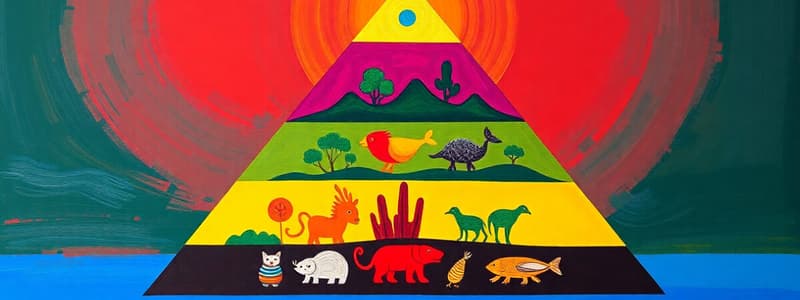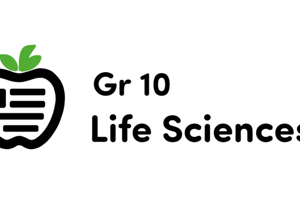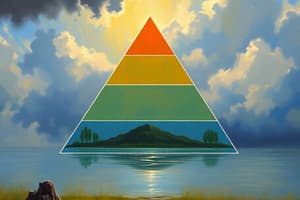Podcast
Questions and Answers
In an energy pyramid, what does the size of each level typically represent?
In an energy pyramid, what does the size of each level typically represent?
- The biomass of the organisms at that trophic level.
- The diversity of species found in that trophic level.
- The amount of energy available at that trophic level. (correct)
- The total number of organisms in that trophic level.
Why do energy pyramids only have a limited number of trophic levels?
Why do energy pyramids only have a limited number of trophic levels?
- Because energy is lost as heat at each trophic level, limiting the energy available to support higher levels. (correct)
- Because nutrient availability decreases at higher trophic levels.
- Because top predators regulate the population sizes of lower trophic levels.
- Because the complexity of ecosystems limits the number of species that can interact.
If producers capture 1000 units of energy from the sun, approximately how much energy is available to secondary consumers in the same ecosystem, assuming typical energy transfer efficiency?
If producers capture 1000 units of energy from the sun, approximately how much energy is available to secondary consumers in the same ecosystem, assuming typical energy transfer efficiency?
- 100 units
- 1000 units
- 1 unit
- 10 units (correct)
How does the energy pyramid model help in understanding the stability and sustainability of an ecosystem?
How does the energy pyramid model help in understanding the stability and sustainability of an ecosystem?
In what way does the energy pyramid model simplify the reality of energy flow within a food web?
In what way does the energy pyramid model simplify the reality of energy flow within a food web?
In an ecosystem's energy pyramid, if the producer level contains 5000 kcal of energy, approximately how much energy is available to the secondary consumers, assuming the ten percent rule applies?
In an ecosystem's energy pyramid, if the producer level contains 5000 kcal of energy, approximately how much energy is available to the secondary consumers, assuming the ten percent rule applies?
Which statement accurately describes the relationship between trophic levels and population size in an energy pyramid?
Which statement accurately describes the relationship between trophic levels and population size in an energy pyramid?
In a deciduous forest ecosystem, which sequence correctly represents the flow of energy from producers to tertiary consumers?
In a deciduous forest ecosystem, which sequence correctly represents the flow of energy from producers to tertiary consumers?
How would the removal of secondary consumers in a coral reef ecosystem most likely affect the energy pyramid?
How would the removal of secondary consumers in a coral reef ecosystem most likely affect the energy pyramid?
If the producers in an energy pyramid create 10,000 kcal of energy, what is the most likely amount of energy that would be transferred to the tertiary consumers in the same pyramid?
If the producers in an energy pyramid create 10,000 kcal of energy, what is the most likely amount of energy that would be transferred to the tertiary consumers in the same pyramid?
Flashcards
Decomposers
Decomposers
Organisms that recycle nutrients from dead organisms back into the soil.
Ten Percent Rule
Ten Percent Rule
Each trophic level obtains only 10% of the energy from the level below.
Energy Pyramid
Energy Pyramid
Diagram showing energy flow; producers at the base, top predators at the peak.
Producers (Forest)
Producers (Forest)
Signup and view all the flashcards
Producers (Coral Reef)
Producers (Coral Reef)
Signup and view all the flashcards
Ecosystem
Ecosystem
Signup and view all the flashcards
Trophic Level
Trophic Level
Signup and view all the flashcards
Producers
Producers
Signup and view all the flashcards
Energy Transfer Rule (10%)
Energy Transfer Rule (10%)
Signup and view all the flashcards
Study Notes
- An energy pyramid is a diagram illustrating energy transfer within an ecosystem.
- Energy pyramids show energy levels in an ecosystem, with larger levels at the bottom indicating more energy.
- An ecosystem includes all living and non-living components in a specific area.
Trophic Levels
- Ecosystems are divided into energetic levels called trophic levels.
- Producers, at the bottom, are organisms that produce their food.
- Primary consumers eat producers.
- Secondary consumers eat primary consumers.
- Tertiary consumers eat secondary consumers.
- A food chain shows predatory connections between single species.
- A food web is a complex diagram of who eats whom, formed by multiple food chains.
Purpose
- Energy pyramids demonstrate and quantify energy flow in an ecosystem.
- They show which trophic levels possess more or less energy and how it's transferred.
Energy Transfer
- Energy transfers from one trophic level to the next through predation.
- All energy in an ecosystem originates from the sun.
- Producers absorb 100% of the sun's energy, utilizing 90% for growth and reproduction, with the rest available to other organisms.
- Producers obtain 100% of the available energy from the sun, using 90% for their needs, leaving 10% for the next level.
- Primary consumers get 10% of the energy from the sun that the producers initially had.
- Secondary consumers get 10% of the energy from the primary consumers, which equates to 1% of the total available energy.
- Tertiary consumers get 10% of the energy contained in the secondary consumers, which equates to 0.1% of the total energy from the sun.
- Decomposers gather remaining energy from dead organisms, recycling nutrients back into the soil.
- This energy transfer follows the ten percent rule.
- The ten percent rule: each trophic level gets 10% of the energy from the level below it.
- Energy availability decreases when moving up through the trophic levels.
- Higher trophic levels support fewer organisms.
- A forest contains more producers like grass and trees, than tertiary consumers like hawks because producers get 100% of the solar energy, but tertiary consumers get 0.1%.
Diagram
- An energy pyramid diagram is triangle-shaped with horizontal sections.
- The largest bottom section represents the producer trophic level, containing the most energy.
- Subsequent levels decrease as you go up, representing the decrease in energy with increasing trophic level.
Deciduous Forest Example
- In a deciduous forest, green plants (grass, trees, shrubs) form the producer trophic level with 100% of the sun's energy.
- Primary consumers include herbivores like grasshoppers, deer, rabbits and other small rodents.
- Secondary consumers eat primary consumers and include foxes, snakes, and other small predators.
- Tertiary consumers at the top are top predators like hawks or wolves.
Coral Reef Example
- In a coral reef, photosynthetic algae (phytoplankton) are the producers.
- Microscopic organisms are the primary consumers.
- Small fish and crustaceans form the next level as secondary consumers.
- Top predators like sharks, dolphins, and sea snakes are the tertiary consumers and occupy the top of the pyramid.
Studying That Suits You
Use AI to generate personalized quizzes and flashcards to suit your learning preferences.




